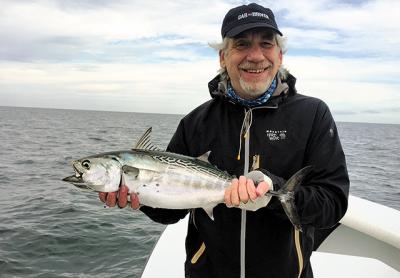Don’t Get Stuck in the Sand

Striped bass and bluefish soon will begin their migration south and, we hope, come within surfcasting range. Fishermen hoping to bend a rod and others eager to observe the spectacle of birds diving, fish crashing bait, and rows of anglers launching lures into the surf will slowly roll their cars off the hard pavement into the soft sand.
Many take the small leap in terrain in Jeeps, pickup trucks, and other four-wheel-drive vehicles suitable for beach driving. Others, however, try their luck in all-wheel-drive S.U.V.s with low ground clearance and often are greeted by the disconcerting sound of spinning tires when they encounter deep and loose sand. At least that was my experience about a dozen years ago when an UpIsland Subaru salesman assured me that I could drive an A.W.D. Outback on East Hampton beaches. To be fair, he wasn’t completely wrong. I was able to drive it downhill from the Indian Wells parking lot and maybe 50 yards more before it sank into deep sand as I began a turn.
The key to successful beach driving is to keep the vehicle’s tires on the surface of the sand. A flatter tire rides higher than a fully inflated one, so airing down each tire to about 20 pounds per-square-inch (P.S.I.) is recommended. If the sand is deep and loose, be prepared to further deflate the tires to 12 to 15 P.S.I. Driving on the compacted sand within existing tire tracks keeps a vehicle from bogging down and puts less strain on its engine.
One reason many people forgo airing down their tires is that the process of sequentially releasing air from four tires is incredibly tedious. But with the availability of small, screw-on automatic tire deflators from Trailhead and other manufacturers, there’s no excuse not to air down when necessary. These neat brass or anodized aluminum devices quickly and accurately deflate all four tires to the user’s desired preset P.S.I. level. The deflators whistle while they work so you can hear when the job is done.
Hammer Towing, a Wainscott-based business that rescues vehicles stuck on the beach, gets multiple calls a week during the summer months, according to Elisha Osborn, its owner. Usually the victim is an A.W.D. car with low ground clearance operated by an inexperienced beach driver who has an incomplete understanding of their car’s capability to maneuver on sand. I met Osborn last Sunday when he was called to aid a driver who had mired her Audi Q5 luxury S.U.V. in the lush sand of Two Mile Hollow Beach in East Hampton, where I happened to be walking my dog.
Interestingly, Land Rover is the brand of vehicle Osborn most often is summoned to free.
Above all, beach driving requires common sense. Every year someone drives too close to the water’s edge or attempts to drive through an area that clearly spells trouble to all but the visually illiterate and then gets to watch his or her car get washed by the sea. That’s certainly not a day at the beach.
On the water, Capt. Merritt White reported that albie fishing continues to be excellent in Gardiner’s Bay, with fish eating feathers, metal, and rubber equally well. Light-tackle fishing for stripers has been tougher as a result of surges from recent southern storms, White noted.
T.J. at Gone Fishing Marina in Montauk said that bottom-fishing remains strong for porgy and sea bass around the Point, while striped bass action is now centered at Southwest Ledge off Block Island. Blackfish up to eight pounds have been landed around Fishers Island, he added.
Harvey Bennett at the Tackle Shop in Amagansett reported stripers along Napeague ocean beaches over the weekend, along with keepers under the full moon Saturday night east of Ditch Plain. There are blues and an occasional striper in the channel leading into Napeague Harbor, porgy and blowfish at the commercial dock, and snappers in local harbors and bays, Bennett said.
Paulie’s Tackle in Montauk reported that Steve Peretto took first place in the shop’s weekend fishing tourney with an 18-pound striped bass. The catch earned the angler a Van Staal VR150 reel. Those willing to hit ocean beaches before sunrise are finding stripers feeding on sand eels, according to the shop.
Sebastian Gorgone at Mrs. Sam’s Bait and Tackle in East Hampton reported blackfish and sea bass north of Plum Island. The porgy bite continues in the bay, he said.
Ken Morse at Tight Lines Tackle in Sag Harbor said that the opening of Sagg Pond resulted in fantastic striper fishing for several hours while efforts to open Mecox Pond have twice failed. Stripers were found at the ferry slip, while monster blues up to 20 pounds hit a Southampton bay beach around the height of the full moon tide. Shinnecock Inlet was surprisingly quiet, Morse added.
Ben McCarron, a.k.a. the Kid, continues to lead the Montauk SurfMasters fall tourney with his 55.14-pound bass. Larry Welcome is in second place with a 23-pound fish, and Wilan Pilco is in third with a 22.3-pound striped bass. Mary Ellen Kane leads the women’s division with a 19.75-pounder. Jon Bruno is on top of the wetsuit division with a 37-pound striped bass.
The Star’s fishing columnist can be followed on Twitter, @ehstarfishing. Photos of prize catches can be emailed to David Kuperschmid at fishreport@ ehstar.com.
